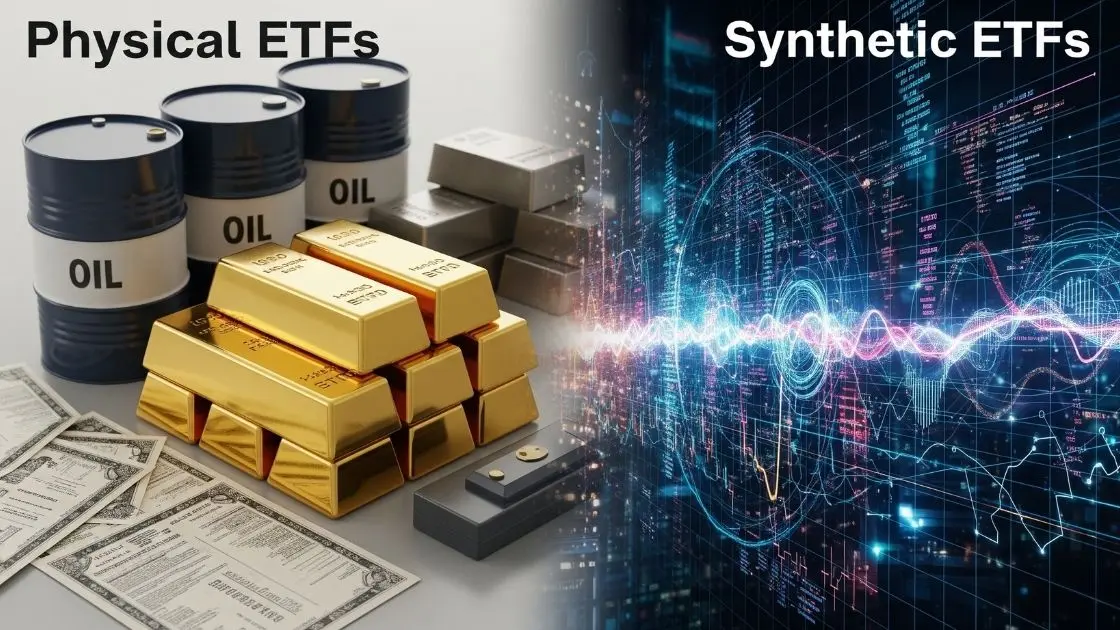Investors might be confused while choosing between physical and synthetic ETFs. Most of them are unaware of the key difference between them or which is better for their investment goals. Understanding the variation is important before deciding which one to choose. Here, we will break down the distinction between physical and synthetic ETFs. We will also share a few tips on how to choose the right investment and the key things to consider. So let’s get started right away!
What are ETFs?
Exchange-Traded Funds (ETFs) are a collection of investments, such as commodities, bonds, and equities. It enables people to invest in a large number of securities at once. EFTs are cheaper compared to other investments. Moreover, they can be easily traded.
How do ETFs Work?
ETFs are funds that can be traded on exchanges by tracking a specified index. When traders invest in an ETF, they can acquire a stack of assets. They can be bought or sold during market hours.
Here’s an outline of how ETFs function.
- An ETF provider builds a container of different assets, including bonds, stocks, commodities, or currencies. Each asset has its own ticker.
- Investors can purchase shares of this container, much like buying a stock in a company.
- ETFs can be traded on an exchange throughout the day.
What are Physical ETFs?
Physical ETS tracks the underlying constituents of an index. These forms of ETFs are more transparent and straightforward. It has zero or limited risk. Some physical ETFs buy a limited stocks in the index, which is termed as sampling.
There are two main types of Physical ETFs. They are:
Full Replication: All securities in the index are bought in the same proportion.
Sampling: Only a few securities are bought to reduce costs and enhance liquidity, especially in the case of large stocks.
Advantages and Disadvantages of Physical ETFs
Before making a decision, it is important to consider the benefits and drawbacks. Here, we will go through the advantages and disadvantages of Physical ETFs.
Advantages
- Transparent: Physical ETFs offer transparency of the index and prices.
- Lower risks: As Physical ETFs are less reliant on external contracts, it is less risky.
- Best for long-term investments: It is best for investors looking for long-term investments.
Disadvantages
- Higher transaction costs
- Errors can arise because of liquidity and costs
What are Synthetic ETFs?
Synthetic ETFs do not have underlying assets; instead, they use swaps, futures, and options to replicate the action of an index. The ETF holder will enter into an agreement with the counterparty, mainly a bank, for the creation of the index. When the index is higher than the total assets of the ETF holder, the counterparty should pay the difference amount to the fund provider.
Advantages and Disadvantages of Synthetic ETFs
Given below are a few advantages and disadvantages of Synthetic ETFs.
Advantages
- Lower chances of error
- Can replicate complex markets
- Less operational costs
Disadvantages
- Lacking transparency
- Risk involving a counterparty
- Concerns about regulators
Difference Between Physical and Synthetic ETFs
Let’s look at the key differences between Physical and Synthetic ETFs.
Counterparty Risks
When it comes to Synthetic ETFs, the returns depend on the counterparty. The Physical ETFs do not have such a risk. When the counterparty bails out, investors can lose their funds.
Transparency and Complexity
Synthetic ETFs are less transparent than Physical ETFs, due to the non-disclosure of information regarding the swaps and derivatives. Moreover, it has complex tools that can be hard to understand.
Cheaper Option
Physical ETFs offer direct access to assets like gold, which can be much more expensive. It also increases the expense ratios, storage fees, and transaction costs. On the other hand, Synthetic ETFs are much cheaper because they are replicated counterparts.
Lower Tracking Errors
Tracking errors occur in Physical ETFs due to factors like fund management, securities, liquidity, sampling issues, and trading fees. On the other hand, Synthetic ETFs have lower tracking errors because they use derivative contracts to replicate indexes.
Which One to Invest in: Synthetic or Physical ETFs?
We can see that Synthetic ETFs gain some edge compared to Physical ETFs in terms of cost and tracking errors. However, we cannot ignore issues of counterparty risk. Investors are risking their hard-earned money for a fast buck. If the counterparty does not oblige with the conditions, investors lose their money. So, for long-term investment plans, we suggest going with Physical ETFs.
How to Choose the Right ETF?
Here are a few factors to consider when choosing an ETF.
Fund Size
Do you want to invest in a small or a large fund size? Size determines investor goals. If you are planning to invest a large amount of money, go for something with higher liquidity and lower costs.
Age of ETFs
New ETFs are launched every year. However, they do not have a history of analyzing its price evolution. So, it is best to look for ETFs that are a couple of years old.
Trading Volumes
You should look at the trading volume of ETFs you are planning to invest in. It can provide a clear picture of the total number of shares, and the higher the volume, the easier it is to sell or buy the shares.
Costs
If you are planning to invest in ETFs, focus on maximizing returns by minimizing costs. You should always look for assets that have minimal costs. While choosing between two ETFs with the same performance, go for the one with the lower fees.
Tracking Error
Tracking error refers to the difference between the ETF’s returns and the benchmark index. Lowering the tracking error indicates the ETF is mirroring the index.
Summary
In this article, we have provided a detailed explanation of the key differences between Physical and Synthetic ETFs. Before choosing an ETF, it is essential to consider various aspects, including the cost, volume, funds invested, and tracking errors. For a long-term investment plan, we recommend investing in Physical ETFs. Also consider personal interests, such as financial goals, time horizon, risk tolerance, portfolio diversification, and sectors traders want to explore.




